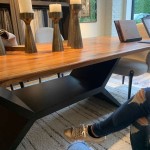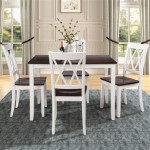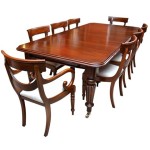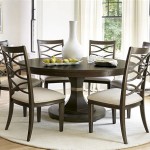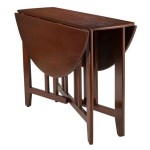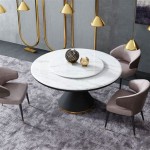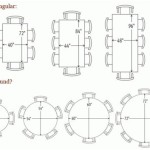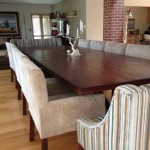72 Round Dining Room Tables: A Comprehensive Guide
The 72-inch round dining room table presents a versatile and impactful furniture choice for various home configurations. This size provides ample space for dining, socializing, and even occasional workspace, making it a considerable investment. Selecting the right 72-inch round dining table involves consideration of material, style, seating capacity, and spatial requirements. This article will explore these critical factors to guide the reader in making an informed decision.
Understanding Size and Space Considerations
The primary advantage of a 72-inch round dining table is its capacity to comfortably accommodate a considerable number of diners. Generally, a 72-inch round table can seat between 8 to 10 people comfortably. However, this number can fluctuate based on the chair style and the desired amount of elbow room. Larger chairs with arms, for example, will reduce the number of people that can be comfortably seated.
Beyond the table's diameter, it's critical to consider the surrounding space. A common guideline dictates that at least 36 inches of clearance is necessary between the edge of the table and any walls or other furniture. This ensures comfortable movement around the table and prevents a cramped dining experience. For a 72-inch round table, this translates to needing a dining area that is at least 144 inches (12 feet) in diameter. However, for higher traffic areas, 48 inches of clearance is preferable, requiring a larger dining space.
Furthermore, consider the potential interference with doorways or other access points. It's prudent to measure the dimensions of the room and strategically position the table to avoid obstructing pathways. A floor plan, even a simple sketch, can greatly assist in visualizing the table's placement and ensuring sufficient space for comfortable use.
The shape of the room also plays a vital role. While a round table can work well in square or rectangular rooms, its impact is most pronounced in square spaces, promoting a balanced and harmonious aesthetic. Rectangular rooms may benefit from a rug to visually define the dining area and anchor the table.
Material Selection and Durability
The material of a 72-inch round dining table significantly influences its aesthetic appeal, durability, and maintenance requirements. Common materials include various types of wood, glass, metal, and composites, each with its own strengths and weaknesses.
Solid wood tables, such as those crafted from oak, maple, or walnut, are prized for their durability and timeless beauty. Oak offers exceptional strength and resistance to wear and tear, while maple provides a smoother, more refined grain. Walnut is known for its rich color and elegant appearance. Solid wood tables require regular maintenance, including dusting, polishing, and occasional refinishing to protect the finish and prevent warping or cracking due to changes in humidity. These tables can be quite heavy and expensive, representing a significant investment.
Veneer tables offer a more affordable alternative to solid wood. They consist of a thin layer of real wood veneer applied over a core of engineered wood, such as plywood or MDF (Medium-Density Fiberboard). Veneer tables can replicate the look of solid wood at a lower cost, and they are less susceptible to warping. However, they are less durable than solid wood and can be damaged by scratches or impacts that penetrate the veneer layer. Care should be taken to protect the surface from excessive moisture and heat.
Glass-topped tables provide a modern and airy aesthetic. They are easy to clean and maintain, and their transparency can make a small dining room appear larger. However, glass surfaces can be prone to scratches and smudges, requiring frequent cleaning. The base material, typically metal or wood, should be chosen for its stability and aesthetic compatibility with the glass top. Tempered glass is essential for safety, as it shatters into small, relatively harmless pieces if broken.
Metal tables, often constructed from stainless steel or wrought iron, offer a contemporary or industrial look. Stainless steel is durable, rust-resistant, and easy to clean, making it a practical choice. Wrought iron provides a more ornate and traditional aesthetic, but it can be susceptible to rust if not properly treated. Metal tables are generally durable and require minimal maintenance, but they can feel cold or sterile in some environments.
Composite materials, such as laminate or acrylic, provide a wide range of design options and can mimic the appearance of wood, stone, or other materials. Laminate surfaces are durable, scratch-resistant, and easy to clean, making them a practical choice for families with children. Acrylic tables offer a sleek and modern look, but they can be prone to scratches and require specialized cleaning products. The overall durability and aesthetic appeal of composite tables depend on the quality of the materials and construction.
Style and Design Considerations
The style and design of a 72-inch round dining table should complement the overall aesthetic of the dining room and the home. Consider the existing furniture, color palette, and architectural features when selecting a table style. Common styles include traditional, modern, contemporary, rustic, and farmhouse, each with its distinct characteristics.
Traditional dining tables typically feature ornate details, such as carved legs, scrolled aprons, and rich finishes. They often incorporate elements of classical design, such as Queen Anne or Chippendale influences. These tables are best suited for formal dining rooms and homes with a classic or traditional style.
Modern dining tables emphasize clean lines, minimalist design, and geometric shapes. They are often constructed from metal, glass, or engineered wood and feature simple, unadorned surfaces. Modern tables are well-suited for contemporary homes and minimalist interiors.
Contemporary dining tables blend elements of modern and traditional styles, creating a balanced and versatile aesthetic. They may feature clean lines and simple forms, but with added details or textures to create visual interest. Contemporary tables are a good choice for homes with a transitional or eclectic style.
Rustic dining tables celebrate natural materials and textures, such as reclaimed wood, live edges, and distressed finishes. They often feature chunky legs, exposed hardware, and a warm, inviting aesthetic. Rustic tables are ideally suited for casual dining rooms and homes with a farmhouse or country style.
Farmhouse dining tables share some similarities with rustic tables, but they typically feature a more refined and polished aesthetic. They often incorporate elements of vintage or antique design, such as turned legs, plank tops, and painted finishes. Farmhouse tables are a popular choice for creating a cozy and inviting dining space.
Beyond the overall style, consider the details of the table, such as the shape and style of the legs, the finish of the surface, and any decorative elements. These details can significantly impact the table's overall aesthetic and its compatibility with the existing decor.
The choice of chairs is also crucial in complementing the table's style. Matching the chair style to the table's design will create a cohesive look, while contrasting chairs can add visual interest and personality. Consider the height and comfort of the chairs, as well as their durability and maintenance requirements. Upholstered chairs offer superior comfort, but they may require more frequent cleaning than wooden or metal chairs.
Finally, consider the lighting above the dining table. A chandelier or pendant light centered above the table can create a focal point and enhance the ambiance of the dining room. The style and size of the lighting fixture should be proportional to the table and the room. Dimmable lighting allows for adjusting the brightness to suit different occasions.
By carefully considering these factors – size and space, material selection, and style considerations – one can make an informed decision about selecting a 72-inch round dining room table that meets both functional needs and desired aesthetic preferences.

Bedford X Pedestal Rustic 72 Round Dining Table With 8 Chairs Room San Francisco By Sierra Living Concepts Inc

Sanford 72 Round Dining Table Greige Century Furniture

72 Round Brown Mahogany Formal Dining Room Table Ap Wal In Customer S Home Traditional Bridgeport By Antiquepurveyor

Sanford 72 Round Dining Table

Hartford 72 Inch Round Dining Room Set Steve Silver Furniture Cart

Morrison 72 Round Dining Table Furniturologie

Sanford 72 Round Dining Table Brunette Century Furniture

White Oak Veneer 72 Inch Round Dining Table Etsy

Anton Round Pedestal Dining Table 48 60 72 West Elm

Bastide Round Table Handmade Solid Wood Rustic 9 Furniture Rustic9 Custom

